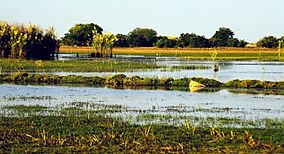Bangweulu Wetlands facts for kids
Quick facts for kids Bangweulu Wetlands |
|
|---|---|
| Bangweulu Swamps | |

View of the wetlands
|
|
The Bangweulu Wetlands are a large wetland area. You can find them in north-eastern Zambia, a country in Africa.
What are the Bangweulu Wetlands?
The name "Bangweulu" means "where the water sky meets the sky." This special place is mostly in Zambia's Northern Province. It is known as one of the world's most important wetlands. The Ramsar Convention has given it this important title. The Ramsar Convention is a global agreement that helps protect wetlands.
This huge region covers about 9,850 square kilometers (3,800 square miles). It has many different types of land. You can find flood-plains, which are flat areas that get covered by water. There are also grasslands that flood during certain seasons. The area also has woodlands and swamps. Rivers nearby feed all these different parts of the wetlands.
Animals and Plants in Bangweulu
The Bangweulu Wetlands are home to many plants and animals. You can see tall Cyperus papyrus plants and floating grasses. There are also miombo woodlands and reeds. These plants provide homes and food for many creatures.
The wetlands are full of crocodiles, different kinds of fish, and many water birds. Some of the mammals living here include buffalo, zebras, elephants, and hippopotamus. You might also spot hyenas, jackals, lechwe, sable antelope, and sitatunga. Millions of straw-coloured fruit bats visit the Mushitu swamp forest. This forest is part of Kasanka National Park, which is near Bangweulu.
In 2016, a group called African Parks worked with Fondation Segré. They helped bring 600 animals back into the wetlands. These animals included hartebeest, impala, and puku.
Bangweulu is also a very important place for birds. BirdLife International has called it an "Important Bird Area." This means it's a key spot for bird conservation. More than 400 types of birds live in these wetlands. Some of them are cormorants, ducks, egrets, Geese, herons, and ibises. You can also see pygmy geese and waders. Other special birds found here include the great white pelican, saddle-billed stork, spoonbill, and wattled crane.
People and Wildlife Living Together
Many villages are located within the Bangweulu Wetlands. Between 50,000 and 90,000 people depend on the wetlands for their lives. This can sometimes lead to problems between people and wildlife.
The ecosystem can be harmed by certain activities. People might burn habitats to clear land for farming. Overfishing can reduce the number of fish. Poaching, which is illegal hunting, also harms the animals. In 2010, 75 poachers were caught. The next year, in 2011, 115 poachers were arrested. Using mosquito nets for fishing is also a problem. These nets catch too many fish, which lowers fish populations in Bangweulu and other parts of Zambia.



